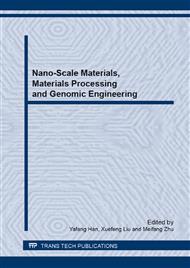[1]
G. I. Taylor, Plastic strain in metals, J. Inst. Met. 62 (1938) 307-324.
Google Scholar
[2]
R. Hill, Generalized constitutive relations for incremental deformation of metal crystals by multislip, J. Mech. Phys. Solids. 14 (1966) 95-102.
DOI: 10.1016/0022-5096(66)90040-8
Google Scholar
[3]
J. R. Rice, Inelastic constitutive relations for solids: An internal-variable theory and its application to metal plasticity, J. Mech. Phys. Solids. 19 (1971) 433-455.
DOI: 10.1016/0022-5096(71)90010-x
Google Scholar
[4]
R. Hill, J. R. Rice, Constitutive analysis of elastic-plastic crystals at arbitrary strain, J. Mech. Phys. Solids. 20 (1972) 401-413.
DOI: 10.1016/0022-5096(72)90017-8
Google Scholar
[5]
F. Roters, P. Eisenlohr, L. Hantcherli, D. D. Tjahjanto, T. R. Bieler, D. Raabe, Overview of constitutive laws, kinematics, homogenization and multiscale methods in crystal plasticity finite-element modeling: Theory, experiments, applications, Acta Mater. 58 (2010) 1152-1211.
DOI: 10.1016/j.actamat.2009.10.058
Google Scholar
[6]
C. A. Bronkhorst, S. R. Kalidindi, L. Anand, Polycrystalline Plasticity and the Evolution of Crystallographic Texture in FCC Metals, Philos. T. Roy. Soc. A. 341 (1992) 443-477.
Google Scholar
[7]
S. R. Kalidindi, C. A. Bronkhorst, L. Anand, Crystallographic texture evolution in bulk deformation processing of FCC metals, J. Mech. Phys. Solids. 40 (1992) 537-569.
DOI: 10.1016/0022-5096(92)80003-9
Google Scholar
[8]
B. Lin, L. G. Zhao, J. Tong, H. J. Christ, Crystal plasticity modeling of cyclic deformation for a polycrystalline nickel-based superalloy at high temperature, Mater. Sci. Eng., A. 527 (2010) 3581-3587.
DOI: 10.1016/j.msea.2010.02.045
Google Scholar
[9]
M. Zhang, J. Zhang, D. L. McDowell, Microstructure-based crystal plasticity modeling of cyclic deformation of Ti–6Al–4V, Int. J. Plasticity. 23 (2007) 1328-1348.
DOI: 10.1016/j.ijplas.2006.11.009
Google Scholar
[10]
C. H. Goh, D. L. McDowell, R. W. Neu, Plasticity in polycrystalline fretting fatigue contacts, J. Mech. Phys. Solids. 54 (2006) 340-367.
DOI: 10.1016/j.jmps.2005.06.009
Google Scholar
[11]
L. Delannay, M. A. Melchior, J. W. Signorelli, J. F. Remacle, T. Kuwabara, Influence of grain shape on the planar anisotropy of rolled steel sheets – evaluation of three models, Comp. Mater. Sci. 45 (2009) 739-743.
DOI: 10.1016/j.commatsci.2008.06.013
Google Scholar
[12]
S. Sinha, S. Ghosh, Modeling cyclic ratcheting based fatigue life of HSLA steels using crystal plasticity FEM simulations and experiments, Int. J. Fatigue. 28 (2006) 1690-1704.
DOI: 10.1016/j.ijfatigue.2006.01.008
Google Scholar
[13]
V. Bachu, S. R. Kalidindi, On the accuracy of the predictions of texture evolution by the finite element technique for fcc polycrystals, Materials Science and Engineering: A. 257 (1998) 108-117.
DOI: 10.1016/s0921-5093(98)00828-4
Google Scholar
[14]
V. Hasija, S. Ghosh, M. J. Mills, D. S. Joseph, Deformation and creep modeling in polycrystalline Ti–6Al alloys, Acta Mater. 51 (2003) 4533-4549.
DOI: 10.1016/s1359-6454(03)00289-1
Google Scholar
[15]
L. Delannay, P. J. Jacques, S. R. Kalidindi, Finite element modeling of crystal plasticity with grains shaped as truncated octahedrons, Int. J. Plasticity. 22 (2006) 1879-1898.
DOI: 10.1016/j.ijplas.2006.01.008
Google Scholar
[16]
Z. Zhao, S. Kuchnicki, R. Radovitzky, A. Cuitino, Influence of in-grain mesh resolution on the prediction of deformation textures in fcc polycrystals by crystal plasticity FEM, Acta Mater. 55 (2007) 2361-2373.
DOI: 10.1016/j.actamat.2006.11.035
Google Scholar
[17]
O. Diard, S. Leclercq, G. Rousselier, G. Cailletaud, Evaluation of finite element based analysis of 3D multicrystalline aggregates plasticity: Application to crystal plasticity model identification and the study of stress and strain fields near grain boundaries, Int. J. Plasticity. 21 (2005) 691-722.
DOI: 10.1016/j.ijplas.2004.05.017
Google Scholar
[18]
L. X. Lv, L. Zhen, Crystal plasticity simulation of polycrystalline aluminum and the effect of mesh refinement on mechanical responses, Mater. Sci. Eng., A. 528 (2011) 6673-6679.
DOI: 10.1016/j.msea.2011.05.040
Google Scholar
[19]
D. Peirce, R. J. Asaro, A. Needleman, An analysis of nonuniform and localized deformation in ductile single crystals, Acta Metallurgica. 30 (1982) 1087-1119.
DOI: 10.1016/0001-6160(82)90005-0
Google Scholar
[20]
R. Quey, P. R. Dawson, F. Barbe, Large-scale 3D random polycrystals for the finite element method: Generation, meshing and remeshing, Comput. Method. Appl. M. 200 (2011) 1729-1745.
DOI: 10.1016/j.cma.2011.01.002
Google Scholar
[21]
A. Gerday, Mechanical behavior of Ti-5553 alloy Modeling of representative cells, in: University of Liège, 2009.
Google Scholar


